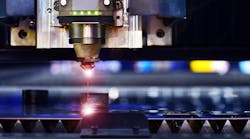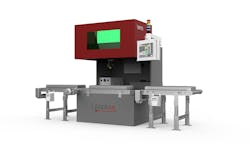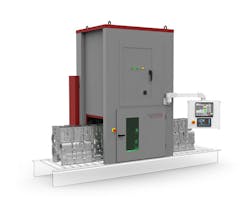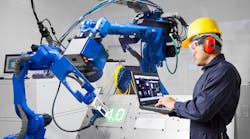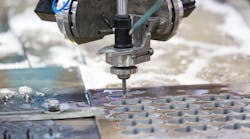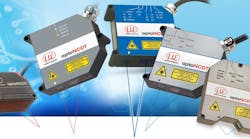Latest from Plant Operations
Integrating Lasers on Conveyors: A Seamless and Efficient Workflow
In 1913, Henry Ford became the first car manufacturer to use conveyor belts in the production of the Ford Model-T. Today, conveyor systems are widely used in the automotive supply chain, and they‘re not going away anytime soon. Lithium-ion batteries, for example, are the most important parts of electric vehicles and are mostly moved from one step to another using conveyors.
The technology supporting conveyor systems keeps evolving. In this article, we’re focusing on how laser systems are integrated into conveyors and used for all types of operations in the automotive industry. This includes everything from laser marking (to implement traceability) to laser cleaning (to prepare surfaces for subsequent manufacturing steps).
Laser systems come with several options that resolve many of the common challenges on conveyors, including inconsistent part positioning or large parts with several areas that need to be processed.
Let’s go over the different types of laser machines and options to understand the different strategies for integrating lasers on conveyors.
The Different Types of Laser Machines
Laser machines installed on conveyors are typically enclosures with door mechanics that control where parts are fed into the machine. These machines can be scaled up or down to fit the dimensions of the conveyor.
There are two main types of laser machines used in conjunction with conveyors:
1. Manually-loaded workstations
2. Fully-automated machines
Manually-Loaded Workstations on Conveyors
Manually-loaded workstations are simple solutions where operators manually position parts into the right area for processing.
In the case of parts that are too heavy for operators to move, these workstations often incorporate transfer tables in the machine to help operators move the parts into the correct position.
Once parts are properly positioned, operators close the door of the enclosure. This contains laser light for safety. A second manual action is required next as operators launch the process with a simple button press.
After the operation is complete, operators open the door and unload the part. The machine is then ready for the next part.
Fully Automated Laser Machine on Conveyor
When the laser process is fully automated, no manual action is required by operators.
The laser machine is fully enclosed to protect the work environment from the laser beam, sitting on top of the conveyor with automated doors on both sides to allow parts to flow through as they move on the conveyor.
If the conveyor already stops to complete other operations, laser processes can be performed quickly during that time. If the conveyor does not stop, the laser process can be performed on the fly. The laser can simply track conveyor movement and dynamically compensate for the part’s movement along the conveyor.
This is the best solution to prevent bottlenecks and keep conveyors running smoothly.
As will be shown, lasers can also be adjusted to overcome part positioning variations that may occur on the conveyor.
Laser Options for Conveyors
Using conveyors to move parts can create several challenges, such as an inconsistent positioning of parts or large parts with several areas that need to be processed.
Machines can be designed with options to mitigate these issues. Here are some of the most common laser options manufacturers are deploying.
Autofocus System
Parts are rarely precisely positioned on conveyors. Misalignment can cause mismarking or inaccurate processing. With an autofocus system, part positioning variations can be detected, and that information is used to automatically adjust the laser process.
On-the-fly autofocusing systems allow you to clean and texture parts of various shapes and sizes while they are moving on the conveyor without slowing it down.
It’s a great solution to automate processing and maintain consistent high-quality results.
Vision System
When part positioning variations are too high on the conveyor, an autofocus system may not be enough if the parts are located beyond the laser’s field of view. In those cases, vision systems can be used to locate parts.
A gantry system (or another system) is then used to move the laser head to the right location to perform the laser process.
Vision systems are also used when there are multiple types of parts. The vision system can detect the part type, then choose the right laser configuration for that part. This allows you to use one machine to handle multiple types of parts on the same conveyor without manual intervention or readjustments.
Gantry System
When the laser head is mounted on a gantry system, it can move along three linear axes. This can be used to cover a larger surface or to process several areas without requiring multiple laser heads.
This is often used in laser cleaning operations that require cleaning large parts. It is also an efficient solution for laser marking operations when manufacturers need to etch multiple marks at different locations on the same part.
Quality Validation
With this option, cameras are installed at various angles to validate the results of the laser process after each operation. This verifies the completion of the process. You can provide automatic quality validation showing, for example, that a surface is sufficiently cleaned or that a 2D code meets the grading requirement.
A Seamless and Efficient Workflow
Laser technology and conveyor systems go hand in hand in multiple industries from primary metals to electric vehicles.
The combination allows manufacturers to create a more seamless and efficient workflow to process large numbers of parts. Manufacturers get consistent high-quality results while eliminating unnecessary consumables.
With the right options and machines, manufacturers can use laser technology on conveyors to implement traceability, clean surfaces easily or even perform laser welding.










